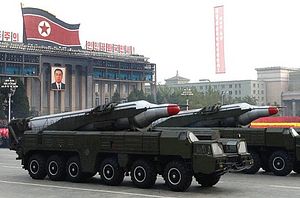North Korea’s approach to its Musudan (BM-25) intermediate-range ballistic missile program seems to be to keep trying until a launch succeeds. Early on Wednesday, Pyongyang fired two more Musudan missiles, bringing the total number of Musudans tested since April to six. Details on the two launches Wednesday remain scant as of this writing, but South Korean military officials have confirmed to the Associated Press that at least one of the two launches failed.
I wrote about Pyongyang’s flurry of Musudan testing not too long ago, after the fourth test on the final day of May this year. There’s something mighty odd about Pyongyang continuously depleting its limited stockpile of Musudan missiles in search of a successful capability demonstration. As other commentators and North Korea watchers have noted, ballistic missile testing is hard and, normally, states seeking to operationalize a ballistic missile capability would have their engineers go back to the drawing board after a failed test, taking their time to figure out what went wrong before a second (or third, or fourth, or fifth) attempt.
Pyongyang’s flurry of testing suggests no such caution. And North Korea, while its known for its brinksmanship and bellicose rhetoric, has actually been fairly measured in its missile testing, taking months between tests to demonstrate some progressive trajectory. A counterpoint to the ongoing 2016 Musudan snafu-fest, for instance, is the parallel testing of the KN-11 submarine-launched ballistic missile. Pyongyang has tested the KN-11 on several occasions, but the tests have been separated by several months.
The Musudan has a particular capability, however, that’s increasingly important to Kim Jong-un. As an IRBM with a suspected range of around 3,500 kilometers, a fully operationalized and tested Musudan would grant North Korea the ability to reliably threaten the U.S. territory of Guam with a nuclear strike. For Kim Jong-un, realizing the nuclear leg of the two-sided byungjin line will require the successful demonstration of a credible deterrent. With the KN-08 and new KN-14 intercontinental ballistic missiles still in testing and development, the Musudan is probably Pyongyang’s best bet to stick it to Washington quickly.
The repeated testing since April suggests that the scientists and engineers working on the Musudan are under pressure. After all, the first test attempt was meant to coincide with Kim Il-sung’s 104th birthday and failed, causing an embarrassment for the Eternal Leader’s grandson. (He’d just tested a purported thermonuclear bomb for his own birthday in January and launched a satellite launch vehicle for his father’s in February.) If we get confirmation the second launched failed as well, Pyongyang may attempt to test again–perhaps as soon as August 15, to celebrate Korean Liberation Day.
The failures to date have been notable, but North Korea’s scientists acquire valuable new information with each test gone wrong, getting closer to their goal of attaining a credible capability to strike U.S. territory. The only limit on testing right now seems to be the possibility of running out of the existing stock of Musudan missiles, but Pyongyang’s still got more missiles in its inventory.































